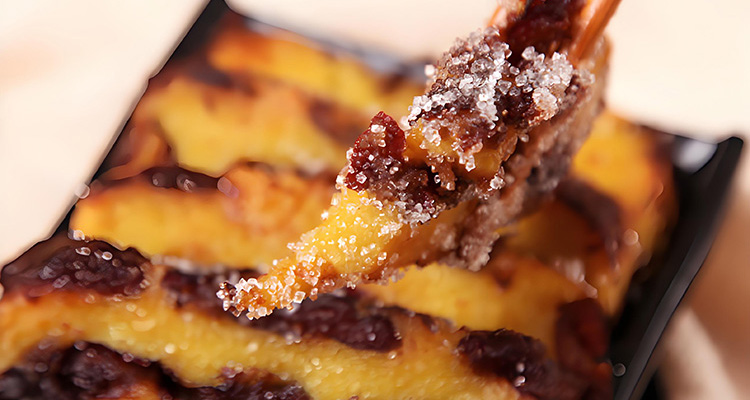Shanxi Zaojie Cake: Loessland Sweetness
In the vast Loess Plateau, Shanxi people transform humble ingredients into memorable flavors. Shanxi Zaojie Cake (a steamed date-and-millet dessert) is a signature of Shanxi cuisine and a comforting taste of home. Made from yellow millet and jujubes (red dates), this soft, naturally sweet cake carries deep cultural meaning and local warmth—an essential treat for food lovers and cultural travelers in Shanxi.
1. Origins: Centuries of Sweetness on the Loess Plateau
Zaojie Cake’s history is rooted in Shanxi’s agrarian traditions. The Loess Plateau produces abundant yellow millet and high-quality jujubes, and locals discovered long ago that steaming these two ingredients together yields a healthy, naturally sweet dessert. Historically reserved for festivals, weddings, and ceremonies, zaojie cake was a symbol of celebration and blessing. The character “jie” in local dialect—suggesting layers or intervals—aptly describes the cake’s layered assembly of millet and dates. Over the centuries it has moved from farmhouse hearths to become a beloved regional specialty across Jinzhong, Lvliang, and beyond.
2. Cultural Meaning: From Family Tables to Wedding Blessings
In Shanxi, zaojie cake is more than food; it’s a cultural emblem. Common at weddings, its jujubes imply wishes for early childbirth (a phonetic link in Chinese) while the cake (gao) suggests rising fortunes—both auspicious symbols for newlyweds. During Lunar New Year and other festivals, families steam zaojie cake to wish for prosperity and sweetness in life. For many Shanxi natives, the cake’s aroma evokes childhood memories—grandmothers tending the stove—and remains a powerful connection to home and tradition.
3. Key Ingredients: Simple, Local, and Flavorful
The authentic flavor of zaojie cake relies on a few quality ingredients:
- Yellow millet (sorgo/millet): Northwest Shanxi produces plump, golden millet with strong stickiness when steamed—responsible for the cake’s chewy, fragrant texture.
- Jujubes (red dates): Famous varieties from Lvliang and Jinzhong are fleshy, sweet, and develop a deep red color and melt-in-mouth softness after steaming.
- Optional sweeteners: Some households add a little white or brown sugar, but the classic recipe emphasizes the jujubes’ natural sweetness.

4. Making Zaojie Cake: Layering and Patience
Traditional zaojie cake is a patient, layered process:
- Soak millet for several hours until fully hydrated; wash and pit the jujubes.
- Line a large steamer (locally called a “zeng”) with damp cloth. Spread a thin layer of soaked millet, then an even layer of jujubes.
- Steam: place the layered steamer over boiling water. When the first layer is half-cooked, add the next millet and date layers.
- Repeat until 3–5 layers are stacked. Steam on high heat for an hour or more, then let rest off the heat so flavors meld thoroughly.
5. Taste and Texture: Soft, Chewy, Naturally Sweet
Fresh from the steamer, zaojie cake reveals alternating bands of golden millet and ruby jujubes. The millet is soft and slightly chewy; the jujubes melt into a dense, fruity sweetness. The dessert’s sugar comes largely from the fruit, producing a gentle, non-cloying sweetness complemented by pronounced grain aroma—comforting and satisfying.
6. How to Eat: Hot, Cold, or Pan-Fried
- Hot: Serve immediately after steaming for the softest, most aromatic experience—the traditional preference.
- Cold: Chilled cake firms up and concentrates sweetness—refreshing in summer and popular as a chilled dessert.
- Pan-fried: Slice cooled zaojie cake, pan-fry in a little oil until golden on both sides. The contrast of crispy exterior and soft interior is a beloved home variation.
7. Where to Try the Most Authentic Zaojie Cake in Shanxi
Tourists can find authentic zaojie cake in several places:
- Local banquets: Attend a Shanxi wedding or celebratory feast, and you’ll likely taste it.
- Heritage restaurants: In historic sites like Pingyao Ancient City, Qiao Family Courtyard, and Wang Family Courtyard, traditional restaurants often serve the cake.
- Time-honored eateries in Taiyuan: Classic Jin cuisine restaurants and established local eateries list zaojie cake among their specialties.
- Markets and snack streets: Street stalls and market vendors sometimes sell home-style versions—great for casual tasting.
8. Traveler Tips: Enjoying Shanxi Flavors Easily
- Best time to eat: Zaojie cake works well as a dessert or part of a meal—try it at lunch or dinner.
- Portions: Cakes are usually generous and meant for sharing—typically suitable for 2–3 people per portion.
- Ordering tips: Ask whether it’s freshly steamed or pan-fried. A steamed serving provides the classic experience.
- Pairings: Balance the cake’s sweet, sticky profile with tangy or savory Shanxi dishes like guo-you rou (oil-fried pork with vinegar) or a bowl of knife-cut noodles.
- Digestion note: The millet is sticky; eat moderately if you have a sensitive stomach.

9. Easy Home Version: Bring Shanxi Home
You can recreate a simple zaojie cake at home:
- Substitute sticky rice if millet is unavailable—texture will vary.
- Use a deep bowl or springform pan in a steamer if you lack a traditional zeng.
- Layer soaked grain and pitted jujubes in a bowl, add just enough water to cover, then steam on high for about one hour. Test with a skewer; grains should be tender. Invert onto a plate and serve.
A steaming bowl of zaojie cake captures the Loess Plateau’s simplicity, Shanxi people’s hospitality, and a timeless wish for sweetness in life. It may lack elaborate plating, but its cultural depth and homely flavor make it unforgettable. When you visit Shanxi, seek out this warm, layered dessert—experience a centuries-old taste that locals proudly pass down at family tables and festive gatherings.


